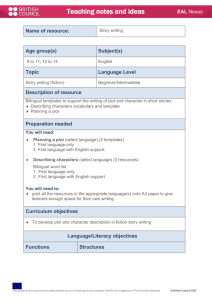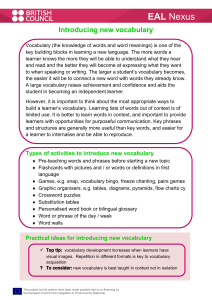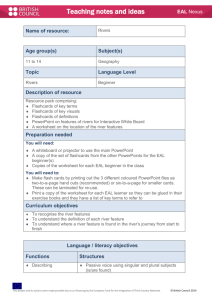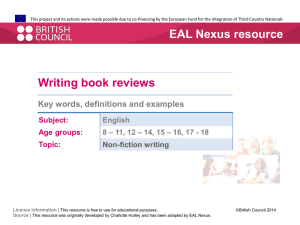Extended version - EAL Nexus
advertisement
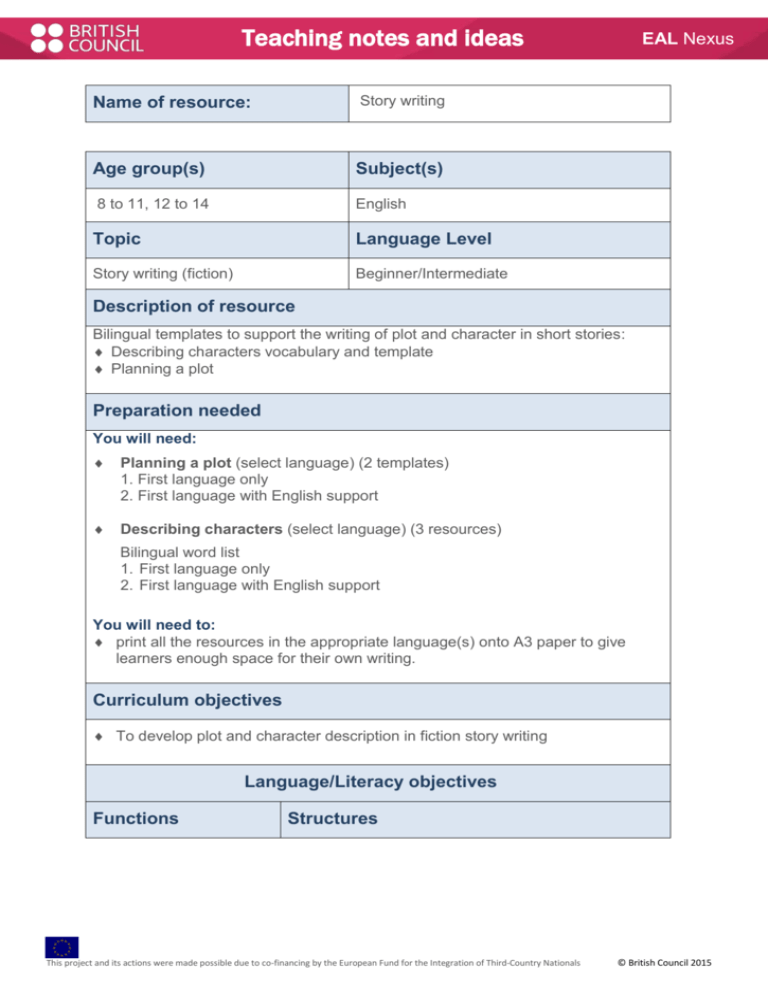
Teaching notes and ideas Name of resource: Story writing Age group(s) Subject(s) 8 to 11, 12 to 14 English Topic Language Level Story writing (fiction) Beginner/Intermediate EAL Nexus Description of resource Bilingual templates to support the writing of plot and character in short stories: Describing characters vocabulary and template Planning a plot Preparation needed You will need: Planning a plot (select language) (2 templates) 1. First language only 2. First language with English support Describing characters (select language) (3 resources) Bilingual word list 1. First language only 2. First language with English support You will need to: print all the resources in the appropriate language(s) onto A3 paper to give learners enough space for their own writing. Curriculum objectives To develop plot and character description in fiction story writing Language/Literacy objectives Functions Structures This project and its actions were made possible due to co-financing by the European Fund for the Integration of Third-Country Nationals © British Council 2015 EAL Nexus Describing Present tense: It (she, he) is/has …; They are/ have …; There is/are … Adjectives to describe setting and character Questioning What is it like? Where is it? When? Who? Vocabulary Adjectives to describe character and place (see full list in resource) This resource could be used: as differentiation within class one to one or small group independent learning Ideas for using the resource What to do These resources should be used in the final stages of a scheme of work on story writing. Activities leading up to this final stage could be made accessible to EAL learners through use of: o Examples of first language/ bilingual stories o Key visuals: e.g. Picture sequencing of well-known stories, labelling visual images of settings. o Role play / drama o Story building dice Print all the resources onto A3. This will give the EAL learner plenty of space to develop their ideas. First, use the Story writing Plot 1 (select language) in the first language only This gives the following instructions for EAL learners in their first language: 1. Name the characters in the story. 2. Write a brief 'beginning, middle, end' summary of the plot in a few sentences. 3. Write where and when the story takes place. 4. Write down a few words/phrases to describe the setting(s) for the story. 5. Write down the ending of the story (how any problems are resolved). Encourage the EAL learner to write down their main ideas in their first language. They can use a first language thesaurus and dictionary (available online) to develop descriptive vocabulary in their first language. This project and its actions were made possible due to co-financing by the European Fund for the Integration of Third-Country Nationals © British Council 2015 EAL Nexus The EAL learner could go on to develop the story further, and write it in their first language, or the first language draft could be used as a stimulus to help to develop the story in English using the Story writing plot 2 (select language) with English support. The EAL learner could use this parallel resource to transfer the basic ideas for their story into English. This could also be done as a collaborative activity with a peer (a good linguistic role model) or with guidance from a supporting teacher who could ask questions such as: o Who are the characters in your story? o What happens in the story? The EAL learner should be encouraged to retell her/his simple story plan idea orally in English, as well as to develop it further through discussion. The EAL learner may also choose to use a bilingual dictionary to find the English for some of the key descriptive vocabulary they have chosen for the first language version of the story. Both these templates could also be used to help the learner to identify the key features of a well-known short story, such as a fairy tale etc. Many of these can be downloaded free from the internet in a range of languages. Developing the main character(s): pre-teach different facial features in English. For example: Ask learners to use magazines to find interesting faces. They can either use a whole face or make their own face by cutting up different features (face, nose, eyes, hair, etc.) . Once they have their features, ask learners to stick them on a sheet of paper to make a visual of their main character. This can be done as a shared speaking activity with a pupil who provides a good English language model. Use Story writing character 1 (select language) first. Ask the EAL learner to write down some ideas about the main character in their first language only, to support the development of ideas. The EAL learner can then talk these ideas through with a peer, or a supporting teacher. This discussion can be supported with the Bilingual word list (select language) and a bilingual dictionary. Using the Bilingual word list and Story writing character 2 (with English), learners write down a description of their character in English This project and its actions were made possible due to co-financing by the European Fund for the Integration of Third-Country Nationals © British Council 2015 EAL Nexus Other ideas for making the best use of this resource This resource could also be used as a barrier game, as follows: Learner 1 has a blank face template; Learner 2 has the completed description of their character’s appearance. Learner 2 describes the character, while Learner 1 draws it. Learner 1 has a blank story plot template. Learner 2 has a completed template. Learner 1 asks questions to Learner 2 and completes each section of the jigsaw with their responses. On completion, the pair compares the result with the original description. Possible extension activities Ask learners to compare the same story written from the perspective of two different cultures, perhaps in different languages. For example: Cinderella is available in both French and English. For this, the EAL learner would need to be provided with appropriate language structures for making comparisons, for example: however, but, similarly, in the same way, … than, short(er), more frightening than. This project and its actions were made possible due to co-financing by the European Fund for the Integration of Third-Country Nationals © British Council 2015
